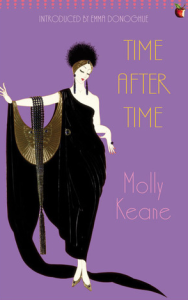
Published in 1983, Time After Time, is Anglo-Irish writer Molly Keane’s second novel under her own name. Before that she published ten novels under her pseudonym M. J. Farrell. There was a break of almost thirty years between her first ten and her last three novels. The early death of her husband was the reason for that long silence. Molly Keane also wrote plays.
Time After Time is my second Molly Keane. Back in 2011, I read and reviewed Two Days in Aragon which I liked very much. At the time, I wanted to know which one to read next and several people recommended Time After Time. Now, finally, nine years later, I picked it up.
What a wild ride. Not what I expected and not how I remember Two Days in Aragon, which was far more about the end of an era, but that doesn’t mean I didn’t like Time After Time. Molly Keane is a brilliant writer. She’s sharp, witty, and has a very distinct sense of humor.
The Swifts, four siblings in their sixties and seventies, live in a ramshackle mansion, Durraghglass, that has seen better days. Their fortune is long gone and so is their youth. The only thing they seem to have in common is a love for their late mother. Because of their mother’s will, they are bound to live together under the same roof. Jasper, May and June have never been married. The oldest sister, April is a widow. If it wasn’t for her and the money she inherited from her late husband, they would have had to sell most of their land. Still, it’s obvious they have no money as the house is constantly cold and decaying.
It becomes obvious very soon that this isn’t an entirely realistic novel. Each of the four characters has a disability. Jasper is one-eyed, April is deaf, May has a hand with only two fingers, and June, the youngest, never went to school because she’s dyslexic. They each have a pet, the sisters have dogs, Jasper has a cat. Just like the siblings, the pets are at each other’s throat constantly. This isn’t a harmonious household. On the contrary. These are four, selfish eccentrics who hate each other.
The character’s eccentricities and aversions, their feelings of self-importance, made reading this so much fun. The dialog is sharp and witty. The characters behave a lot like characters in one of those hotel novels, we all like so much. Thrown together by fate but kept together by some sort of lethargy. They could avoid each other, but no, they always eat together. And since Jasper reigns over the kitchen, together with his formidable cat, he holds a lot of power. When he wants to punish his sisters, he lets them wait for their dinner or serves something he knows they hate. The meals are, invariably, accompanied by bickering and snide remarks. Here’s a short snippet
(. . . ) there was silence until Jasper broke it with a curious cry: “What are you doing May? Picking the cucumber out of your salad?”
“You rather forgot my ulcer – I can’t eat cucumber.”
“Can’t eat this, can’t eat that. Why must you have such a lower middle-class stomach?”
“Perhaps it has something to do with your idea of Cordon Bleu cooking?”
“It takes imagination and a reasonable digestion to appreciate good cooking.”
“You don’t usually cook cucumber, do you?” The argument drifted into silence.
Pudding time came. Baby rhubarb and rice cream with a vaporous suggestion of nutmeg.
“I hope the rhubarb isn’t too acid for your ulcer.” Jasper eyed May’s lavish helping.
“My ulcer must take its chances (. . . )”
While the book is often farcical, the characters aren’t devoid of tragedy. They are all elderly and suffer from different ailments. Even though they try to hide it as best as they can, they are very lonely. This and many other uncomfortable truths are brought out into the open when a long-lost childhood friend appears on their doorstep —cousin Leda from Vienna, who they believed had died in a concentration camp. Leda, who once was a great beauty, is now very fond of alcohol and food. But since she’s blind, she still believes she’s charming and imagines her friends to be still as young and charming as herself.
These were the submerged days that Leda’s coming rescued from a deep oblivion. Since she could not see Durraghglass in its cold decay, or her cousins in their proper ages, timeless grace was given to them in her assumption that they looked as though all the years between were empty myths. Because they knew themselves so imagined, their youth was present to them, a mirage trembling in her flattery as air trembles close to the surface of summer roads.
The safety and monotony of their days is soon gone because Leda isn’t as cute or nice as they remember her. Oh no. She’s rather diabolical and a master schemer. If they weren’t so desperate for company and flattery, they might have been able to see through her. Being gullible, they fall into her traps. By the end of the novel, the siblings must face unflattering truths about themselves and nothing is as it was before.
In her foreword Emma Donoghue compares Molly Keane to Jane Austen and Charles Dickens. The book combines, as she says, social comedy, grotesque descriptions and plot twists. I’m not so fond of comparisons like that, but I agree, Time After Time, has all these elements, combined with a terrific writing style, that’s very much her own. For some people these characters might be a bit over the top, but I liked them very much. They are eccentric and mean, but tragic in their own way. And, most importantly, never dull.
